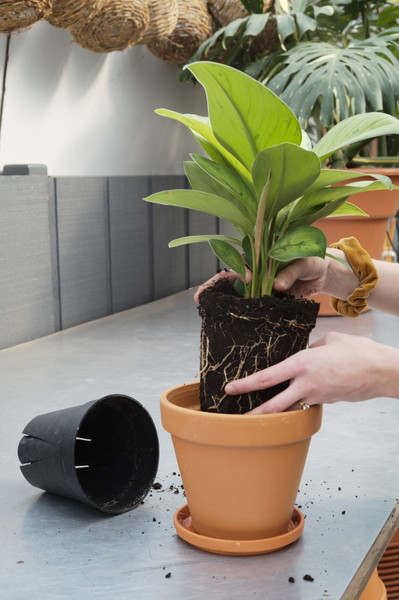Your Guide to Repotting Indoor Plants
Posted by Jessie Jacobson on Sep 17th 2025
Your Guide to Repotting Indoor Plants
As the days get longer, we experience a welcome increase in sunlight. This signals our plants to wake up and start growing. Now is a great time to think about re-potting indoor plants!
Plants will let you know when it is time to repot
- The soil is depleted of nutrients; plants will look pale in color
- The plant is root-bound; there are more roots than soil in the pot
- The height of the plant is greater than 3x the height of the pot its planted in. Exceptions for floor plants and certain design aesthetics.
- Roots are pushing out the bottom of the pot or encircling the stem.
- Plant growth has slowed or ceased, and it is not due to winter dormancy.
- The soil has lost its water-holding capacity requiring more frequent watering; water funs right out the drainage hole each time you water.
- The plant is top heavy or is unstable.
How to choose a container
When repotting plants for the purpose of increasing the root zone, we recommend bumping your plant up one size. Grower pots are generally sized in even numbered inches: 4", 6", 8", 10 etc.
Always choose a pot with drainage. Grower or Nursery pots as they are often referred to are great place to start. These can be easily inserted or "dropped into" decorative containers that do not contain drainage. Simply take your plant to the sink to water, let it drain, then return it to its decorative container.
If you like to plant directly into decorative container, that's just fine. Terra cotta pots almost always have a drain hole and corresponding saucer. Also, when you purchase a pot at Tonkadale we are happy to drill a hole for you - just ask at check-out!
Check out our video on using grower pots/nursery planters as drop-in containers!
How to choose a potting soil
Potting soil is the foundation of plant success. A proper potting mix ensures that your plant has everything it needs including micro and macro nutrients, aeration (oxygen), and water retention. All-purpose potting soil will work great for most repotting projects but do take a minute to consider a specialty soil if you are growing orchids, African violets, bonsai plants, cactus, succulents. We recommend our house blend, Tonka Terra Indoor Potting Soil for basic planting needs and we love Sol Soils' Cactus Gritty Mix for our succulent and cactus friends!
Time to repot
When it's time to repot, it's nice to have a plan in place. Use a long and low Rubbermaid (or other) bin to catch the mess. Don't be afraid to get in there and get a little rough, plants can handle it!
- Gently pull the plant out of the old pot. You can loosen the pot from the plant by squeezing or pressing on the pot.
- Break up the root ball to "wake up" the roots.
- Add a few inches of soil to new pot.
- Place your plant in the new pot.
- Back fill in soil around the plant.
- Lightly tamp down soil
- Water-in well - until the soil drains out the bottom of the pot.
- Nice work!

